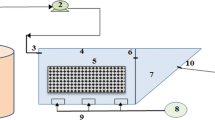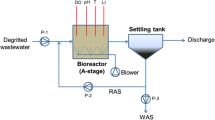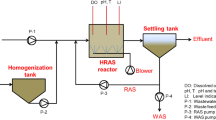Abstract
Treating the industrial wastewater is one of the most important methods to help the environment around the humans. In this research, an experimental study was conducted to evaluate chemical oxygen demand (COD) reduction from a synthetic laboratory-scale integrated fixed-film activated sludge (IFAS) system. The IFAS reactor can have a high influence on treating wastewater containing hazardous environmental pollutants from industrial wastewater in various cycle times (CT). The ethylene glycol (EG) with the concentrations of 600, 800, 1200, and 1800 mg/L by CT of 2, 2.5, 3, 3.5, and 4 h are considered to obtain the mixed liquor suspended solids (MLSS), food-to-microorganism ratio (F/M), organic loading rate (OLR), surface organic loading rate (SLR) and COD reduction parameters. The experimental results showed that the highest EG and COD removal of the IFSA system occurred at the highest CT (CT = 4 h). The results showed that the COD reduction efficiency of the system has an inverse effect on the volume fractions of ethylene glycol. Moreover, the F/M of the system with an EG of 1800 mg/L was about 2.3 kgCOD/KgMLSS. Moreover, the amount of the OLR of IFAS with an EG of 600 mg/L was 5.4 kgCOD/m3d at a cycle time of 2 h. Additionally, the highest amount of SLR and MLSS of the system was obtained in EG of 1800 mg/L, which were about 43.3 gCODm2/d and 4650 mg/L, respectively.








Similar content being viewed by others
Abbreviations
- CT:
-
Cycle time
- EG:
-
Ethylene glycol
- MBBR:
-
Moving bed biofilm reactor
- MLSS:
-
Mixed liquor suspended solids
- COD:
-
Chemical oxygen demand
- OLR:
-
Organic loading rate
- SLR:
-
Surface organic loading rate
- F/M:
-
Ratio of food to microorganisms
References
Abd Elbar AR, Hassan H (2020) Enhancement of hybrid solar desalination system composed of solar panel and solar still by using porous material and saline water preheating. Sol Energy 204:382–394
An Y, Xing Y, Wei J, Zhou C, Wang L, Pan X, Wang J, Wang M, Pang H, Zhou Z (2022) Performance and microbial community of MBBRs under three maintenance strategies for intermittent stormwater treatment. Sci Total Environ 851:158578
Dehboudeh M, Dehghan P, Azari A, Abbasi M (2020) Experimental investigation of petrochemical industrial wastewater treatment by a combination of integrated fixed-film activated sludge (IFAS) and electro-Fenton methods. J Environ Chem Eng 8:104537
Dhivagar R, Shoeibi S, Parsa SM, Hoseinzadeh S, Kargarsharifabad H, Khiadani M (2023) Performance evaluation of solar still using energy storage biomaterial with porous surface: an experimental study and environmental analysis. Renewable Energy 206:879–889
Dutta D, Arya S, Kumar S (2021) Industrial wastewater treatment: current trends, bottlenecks, and best practices. Chemosphere 285:131245
Federation, Water Environmental, and APH Association (2005) Standard methods for the examination of water and wastewater, American Public Health Association (APHA), Washington, DC, USA
Fellaou S, Ruiz-Garcia A, Gourich B (2021) Enhanced exergy analysis of a full-scale brackish water reverse osmosis desalination plant. Desalination 506:114999
Foyle L, Burnett M, Creaser A, Hens R, Keough J, Madin L, Price R, Smith H, Stone S, Kinobe RT (2023) Prevalence and distribution of antimicrobial resistance in effluent wastewater from animal slaughter facilities: a systematic review. Environ Pollut 318:120848
Gogate PR, Pandit AB (2004) A review of imperative technologies for wastewater treatment I: oxidation technologies at ambient conditions. Adv Environ Res 8:501–551
Grabas M (2000) Organic matter removal from meat processing wastewater using moving bed biofilm reactors. Environ Prot Eng 26:55–62
Hassan H, Yousef MS (2021) An assessment of energy, exergy and CO2 emissions of a solar desalination system under hot climate conditions. Process Saf Environ Prot 145:157–171
Hassani AH, Borghei SM, Samadyar H, Ghanbari B (2014a) Utilization of moving bed biofilm reactor for industrial wastewater treatment containing ethylene glycol: kinetic and performance study. Environ Technol 35:499–507
Jabari P, Munz G, Oleszkiewicz JA (2014) Selection of denitrifying phosphorous accumulating organisms in IFAS systems: comparison of nitrite with nitrate as an electron acceptor. Chemosphere 109:20–27
Jin Y, Wang D, Zhang W (2016) Treatment of high-strength ethylene glycol waste water in an expanded granular sludge blanket reactor: use of PVA-gel beads as a biocarrier. Springerplus 5:1–8
Joss A, Zabczynski S, Göbel A, Hoffmann B, Löffler D, McArdell CS, Ternes TA, Thomsen A, Siegrist H (2006) Biological degradation of pharmaceuticals in municipal wastewater treatment: proposing a classification scheme. Water Res 40:1686–1696
Kim H-s, Schuler AJ, Gunsch CK, Pei R, Gellner J, Boltz JP, Freudenberg RG, Dodson R (2011) Comparison of conventional and integrated fixed-film activated sludge systems: attached-and suspended-growth functions and quantitative polymerase chain reaction measurements. Water Environ Res 83:627–635
Li X, Engel BA, Duan P, Sun S, Wang Y (2022) Developing an agricultural water pricing model considering both physical and virtual water: a case study of an irrigation district in China. J Clean Prod 368:133043
Liu X, Chuanbo Fu, Wang M, Wang J, Zou H, Le Y, Chen J (2022) High-gravity technology intensified Knoevenagel condensation-Michael addition polymerization of poly (ethylene glycol)-poly (n-butyl cyanoacrylate) for blood-brain barrier delivery. Chin J Chem Eng 46:94–103
Liu J, Zhonghao Fu, Liu W (2023) Impacts of precipitation variations on agricultural water scarcity under historical and future climate change. J Hydrol 617:128999
Mannina G, Capodici M, Cosenza A, Di Trapani D, Zhu Z, Li Y (2020) Integrated fixed film activated sludge (IFAS) membrane bioreactor: the influence of the operational parameters. Biores Technol 301:122752
Mendelson NL, Fitzgerald A, Kumar A, Pineda JA, MacDougall J, Solomon RJ, Gibson PC, Prikis M, Marroquin CE (2017) Impact of ethylene glycol toxicity on donor organ viability: a case report. Transpl Proc 49:2411–2414
Oh H-S, Yeon K-M, Yang C-S, Kim S-R, Lee C-H, Park SY, Han JY, Lee J-K (2012) Control of membrane biofouling in MBR for wastewater treatment by quorum quenching bacteria encapsulated in microporous membrane. Environ Sci Technol 46:4877–4884
Parsons S (2004) Advanced oxidation processes for water and wastewater treatment. IWA publishing, London
Qi K, Li Z, Zhang C, Tan X, Wan C, Liu X, Wang Li, Lee D-J (2020) Biodegradation of real industrial wastewater containing ethylene glycol by using aerobic granular sludge in a continuous-flow reactor: performance and resistance mechanism. Biochem Eng J 161:107711
Regmi P, Thomas W, Schafran G, Bott C, Rutherford B, Waltrip D (2011) Nitrogen removal assessment through nitrification rates and media biofilm accumulation in an IFAS process demonstration study. Water Res 45:6699–6708
Rosso D, Lothman SE, Jeung MK, Paul Pitt W, Gellner J, Stone AL, Howard D (2011) Oxygen transfer and uptake, nutrient removal, and energy footprint of parallel full-scale IFAS and activated sludge processes. Water Res 45:5987–5996
Salarabadi A, Rahimi M (2020) Experimental investigation of using an evaporation inhibitor layer in a solar still. Sol Energy 206:962–973
Shim W, Kim CE, Lee M, Lee SH, Park J, Do M, Yang J, Lee H (2019) Catechin solubilization by spontaneous hydrogen bonding with poly(ethylene glycol) for dry eye therapeutics. J Control Release 307:413–422
Shoeibi S, Saemian M, Khiadani M, Kargarsharifabad H, Mirjalily SA (2023) Influence of PV/T waste heat on water productivity and electricity generation of solar stills using heat pipes and thermoelectric generator: an experimental study and environmental analysis. Energy Convers Manage 276:116504
Silva AMT, Oliveira ACM, Quinta-Ferreira RM (2004) Catalytic wet oxidation of ethylene glycol: kinetics of reaction on a Mn–Ce–O catalyst. Chem Eng Sci 59:5291–5299
Singh NK, Kazmi AA (2016) Environmental performance and microbial investigation of a single stage aerobic integrated fixed-film activated sludge (IFAS) reactor treating municipal wastewater. J Environ Chem Eng 4:2225–2237
Singh AK, Kumar A, Chandra R (2022) Environmental pollutants of paper industry wastewater and their toxic effects on human health and ecosystem. Bioresource Technology Reports 20:101250
Sodhi V, Singh C, Cheema PPS, Sharma R, Bansal A, Jha MK (2021) Simultaneous sludge minimization, pollutant and nitrogen removal using integrated MBBR configuration for tannery wastewater treatment. Biores Technol 341:125748
Sriwiriyarat T, Randall CW (2005) Performance of IFAS wastewater treatment processes for biological phosphorus removal. Water Res 39:3873–3884
Sriwiriyarat T, Pittayakool K, Fongsatitkul P, Chinwetkitvanich S (2008) Stability and capacity enhancements of activated sludge process by IFAS technology. J Environ Sci Health Part A 43:1318–1324
Tarpani RR, Azapagic A (2023) Life cycle sustainability assessment of advanced treatment techniques for urban wastewater reuse and sewage sludge resource recovery. Sci Total Environ 869:161771
Xu X, Liu G-H, Li Q, Hongchen Wang Xu, Sun YS, Zhang J, Liu S, Luo F, Wei Qi (2021) Optimization nutrient removal at different volume ratio of anoxic-to-aerobic zone in integrated fixed-film activated sludge (IFAS) system. Sci Total Environ 795:148824
Yang S, Yang F, Zhimin Fu, Wang T, Lei R (2010) Simultaneous nitrogen and phosphorus removal by a novel sequencing batch moving bed membrane bioreactor for wastewater treatment. J Hazard Mater 175:551–557
Young B, Delatolla R, Kennedy K, Laflamme E, Stintzi A (2017) Low temperature MBBR nitrification: microbiome analysis. Water Res 111:224–233
Zhang K, Zhang J, Li J, Zheng Z, Sun M (2022) Analyzing the roles of cyclic dimeric guanosine monophosphate (c-di-GMP) on the formation of autotrophic granules and autotrophic biofilm in integrated fixed-film activated sludge (IFAS) reactor. Environ Technol Innov 26:102304
Funding
The authors declare that no funds, grants, or other support were received during the preparation of this manuscript.
Author information
Authors and Affiliations
Contributions
ZJ contributed to methodology, software, conceptualization, formal analysis and writing—review & editing. SS contributed to software, conceptualization, formal analysis, visualization, supervision, validation, project administration and writing—review & editing.
Corresponding author
Ethics declarations
Conflict of interest
The authors declare that they have no conflicts of interest.
Ethical approval
This is an observational study. The research has confirmed that no ethical approval is required.
Consent to participate
Informed consent was obtained from all individual participants included in the study.
Additional information
Editorial responsibility: N.S.El-Gendy.
Rights and permissions
Springer Nature or its licensor (e.g. a society or other partner) holds exclusive rights to this article under a publishing agreement with the author(s) or other rightsholder(s); author self-archiving of the accepted manuscript version of this article is solely governed by the terms of such publishing agreement and applicable law.
About this article
Cite this article
Jangi, Z., Shoeibi, S. Performance evaluation of the integrated fixed-film activated sludge (IFAS) for industrial wastewater treatment containing ethylene glycol. Int. J. Environ. Sci. Technol. 21, 5491–5498 (2024). https://doi.org/10.1007/s13762-023-05446-y
Received:
Revised:
Accepted:
Published:
Issue Date:
DOI: https://doi.org/10.1007/s13762-023-05446-y




